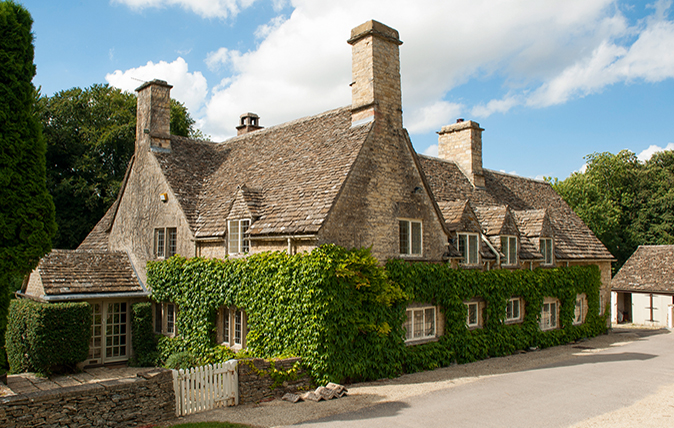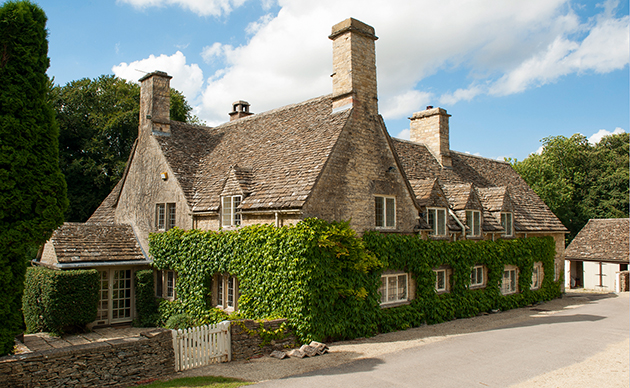Arts and Crafts country houses for sale
Two of the best Arts & Crafts houses in the country have come onto the market


Penny Churchill finds two beautiful Arts & Crafts houses for sale, one in West Sussex and one in Gloucestershire
When Edwin Lutyens observed that ‘there will never be great architects or great architecture without great patrons’, he might have been reflecting on his own remarkable ability to attract influential patronage at key moments in a stellar career that spanned more than 50 years.
It all took off in 1889, when Lutyens met the celebrated artist, writer and gardener Gertrude Jekyll, who introduced him to Society and to Edward Hudson, who founded Country Life in 1897, the same year that Lutyens married the aristocratic Lady Emily Bulwer-Lytton. A year later, Miss Jekyll’s brother, Sir Herbert Jekyll, secured the up-and-coming architect the commission to design the British Pavilion for the Paris Exhibition of 1900.
Things went from good to better and Lutyens had already designed an impressive portfolio of country houses —among them Deanery Garden at Sonning, Berkshire, Goddards at Abinger Common, Surrey, and Marshcourt at Stockbridge, Hampshire— when, in April 1902, he was consulted by Ernest Blackburn, a former prep-school headmaster with a passion for gardening, who had retired on receiving a substantial inheritance from his father, a successful wine merchant.
Between 1901 and 1902, Blackburn bought up land around the village of Thakeham, West Sussex, creating a 130-acre estate that he set about landscaping. He commissioned the architect John Hatchard-Smith to build a house on the site, but was unhappy with the brick house that was emerging. On the advice of Miss Jekyll, he brought in Lutyens, who suggested that the building be demolished and replaced with a house of local Pulborough stone. The half-finished villa was knocked down, except for part of the walls, which were incorporated into the tile-hung service wing, Hatchard- Smith was paid off and Lutyens was engaged to build a dream, Elizabethan-style manor house on the site. However, the matter didn’t end there. Hatchard-Smith accused Lutyens of professional misconduct and there ensued a furious public row, played out in the pages of Building News, which supported Hatchard Smith, and COUNTRY LIFE, which sided with Lutyens.
Lutyens was cleared of all blame and went on to build Little Thakeham in a restrained, elegant style described in COUNTRY LIFE (August 28, 1909) as ‘the simplicity of aristocratic eclecticism’, which reminded an approving H. Avray Tipping of ‘a Quaker lady of two generations ago. She must be in grey. Her dress must have neither flounce nor furbelow… But the silk shall be of the best, the tone choice, the cut and the sewing skilled. She therefore has distinction… Thakeham bears the same impress and is exceedingly agreeable’.
Lutyens thought so, too, and of all the private houses he was to build, Little Thakeham—one of the first in which he combined neo-Classical architecture with his trademark vernacular style—remained, for him and his admirers, ‘the best of the bunch’.
Exquisite houses, the beauty of Nature, and how to get the most from your life, straight to your inbox.

The H-plan main house, completed in 1903 and now listed Grade I, was built of the local stone, which weathered quickly to give the house a 16thcentury Cotswolds manor look. Lutyens’s love of grand internal vistas is reflected in the interior, in which nearly three-quarters of the central portion of the house is taken up by open space—notably, the wide corridor running the length of the house and linking all the main rooms and the towering double-height drawing room (below), with its Juliet balcony and signature oriel window making a vast, open entertaining area with a dining room and sitting room on either side. The formal terraced gardens to the south of the house were laid out by Lutyens, with the original planting carried out by Blackburn himself.

In 1979, Little Thakeham and its gardens were bought by Mr and Mrs Ratcliff, who transformed it into a bijou country-house hotel, having obtained vital planning consent to create eight bathrooms, where previously there were two—a rare concession for a Grade I-listed building. Having held their wedding reception there in the mid 1990s, the present owners, Ashleigh and Nicholas Wigley, had fallen in love with the house and snapped it up when it came on the market five years later.
The couple skilfully adapted the interior for practical family living, splitting the house into three main areas and creating a separate private wing around the kitchen/breakfast room and sitting room, with access to the sheltered east terrace.
Upstairs, Lutyens’s original nursery area was converted into a splendid south-facing master suite, with three more bedroom suites taking up the former master’s and mistress’s bedrooms in the west wing and a further two suites occupying the eastern end of the house. There are three more bedrooms and two bathrooms on the second floor, with a further suite of rooms on the lower-ground floor.

By 2013, their children had grown up and Mr and Mrs Wigley decided to downsize. Little Thakeham was placed on the market, but quickly withdrawn when a mini-tornado tore through the house, ripping off a large part of the roof and severely damaging the oriel window (left). Now painstakingly restored and rebuilt by the gifted stonemasons of Sussex-based Chichester Stoneworks, the imposing neo-Tudor mansion, which nestles on the edge of the South Downs with glorious unspoilt views in all directions, has been launched on the market with 15 acres of gardens and pasture, at a guide price of £6 million through Strutt and Parker (020–7629 7282).
Sir Edwin Lutyens’s views on the importance of good connections might have been echoed by his fellow Arts-and-Crafts architect Ernest Gimson, a modest man who enjoyed a long and harmonious relationship with his own patron, the Earl Bathurst, whose seat was Cirencester Park, Gloucestershire. Dubbed by Pevsner ‘the greatest of the English architect designers’, in 1893, Gimson moved to the Cotswolds, where he undertook a number of commissions for Lord Bathurst and helped to shape the picturesque estate village of Sapperton.

In 1903, funded by Lord Bathurst, Gimson built a house for himself in a wonderfully private setting on the edge of the village, which backs onto Cirencester Park. Built to a compact L-plan by local craftsmen—except for the thatched roof, which was replaced by stone tiles following a fire in 1941 —The Leasowes, listed Grade II, exemplifies the ‘austere beauty’ of a late Arts-and-Crafts cottage, with some 3,670sq ft of accommodation on two floors, including three reception rooms, a garden room, four bedrooms and three bathrooms.
When Gimson died in 1919, the house, listed Grade II, was retained by the Bathurst estate and has been rented out in recent years. Now in need of a modicum of renovation, it is being sold—for the first time ever —with extensive outbuildings, stabling, barns and kennels and some 18.765 acres of idyllic gardens, paddocks, wildflower meadow and woodland. Hamptons International (01285 580170) quote a guide price of £3m.

